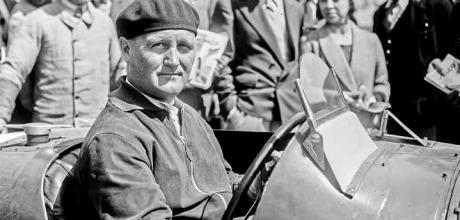Count Stanisław Czaykowski - Gone but not forgotten
War hero, aristocrat, and a brave racing driver who deserves more than a mere footnote in history.
Gone but not forgotten
WORDS PIOTR R FRANKOWSKI
BIBLIOTHÈQUE NATIONALE DE FRANCE
Count Stanisław Czaykowski was the antithesis of a celebrity: he showed up, he drove. He didn’t care if people knew how much money he had and his wife always accompanied him at races. His family, a branch of a noble clan, had emigrated to the Netherlands from Poland in the 19th Century when the Polish state was partitioned by Russia, Prussia and Austro-Hungary and those who could escape the persecution started new lives elsewhere.
Stanisław was born in The Hague in 1899 and, growing up, had absolutely no intention of relying on family wealth for an easy life. He joined the French Foreign Legion aged 17 and fought with distinction in World War One. Later in life, while preparing for night practice at Le Mans, he compared getting up pre-dawn at La Sarthe to awaking in a cold, damp trench.
As a naturalised Frenchman, the Count owned a house in Paris but lived mostly at his mansion in Cap d’Ail on the French Riviera. Little is known of his career but, having built his own fortune, at the age of 30 he decided to race cars and bought a Bugatti Type 35A from Nice-based Bugatti agent Ernest Friderich.
Friderich was an accomplished racer and became Czaykowski’s friend and mentor. Since the Count was not a works driver, he had to pay for his car to be upgraded by the Molsheim factory and, in a smart move, poached brilliant Alsatian mechanic Jean Georgenthum. Known affectionately to Czaykowski as ‘Yéri’, he remained his personal mechanic to the end. The Count’s first race was the Grand Prix du Comminges in France’s Haute-Garonne and the inexperienced Pole calmly won the under-1500cc class. In 1930 he contested five Grands Prix, bought a faster T35C mid-season, and finished fourth in the French GP. The following year he finished last at Monaco, which angered him enough to invest in a Type 51. Czaykowski then won the Casablanca GP with it. He subsequently drove well in the qualifying session for the Grand Prix of Geneva, but while taking evasive action crashed into the porch of a house in Meyrin, fatally wounding a spectator. The Count broke a rib and injured his leg, but it didn’t discourage him. He did well in the Grand Prix de la Marne, run at the Reims-Gueux circuit, and also led the Dieppe GP, cementing his status as a racing driver on a European level.
The Tunis GP in April 1932 had an entry list comprising such names as Varzi, Chiron, Wimille, von Morgen, Veyron, Fagioli, Dreyfus, Étancelin… and Czaykowski. He drove faultlessly to finish fifth. At Monaco he was luckless again. Chiron crashed while lapping the Count through the Chicane, and blamed him, unfairly. In further races, Czaykowski beat Louis Trintignant and challenged Étancelin.
Then came Le Mans. He was paired with Ernest Friderich, and for 21 hours they ran solidly in fourth until an oil line broke and the Bugatti dealer had to stop with a seized engine. Unfazed, the Count beat Pierre Veyron in Nice, won at Comminges and, persuaded by Earl Howe, tried his luck at Brooklands and found the fast, deadly track to be his cup of tea.
Sadly, his Type 51 threw a conrod during the British Empire Trophy yet, as he had become increasingly confident of his ability to handle really high speeds, Czaykowski ordered the 5.0-litre Type 54, a car as fast as it was unreliable. He took delivery in 1933 and promptly took it to Berlin to get used to Avus.
He successfully beat six world records there and saw his name featured in Dunlop and Castrol advertising. The idea of stormtroopers saluting a Polish driver with a French passport seems inconceivable today.
During the Avusrennen, he took the lead at the start and did not relinquish it until lap 14 when Varzi, in a similar Bugatti, passed him after a long struggle. Czaykowski took the lap record (achieving 221.72km/h) on the last lap and finished just 0.2sec behind the Italian. It was regarded as the finest drive of his career. Le Mans and Montlhéry saw mechanical failures, but Czaykowski became the first non-British driver to win the British Empire Trophy 500- mile race at Brooklands.
He kept racing, winning his class at Dieppe while his wife – who usually took care of the timekeeping and supervised refuelling – won the accompanying concours d’élégance with her Bugatti Type 55.
Then came 10 September 1933. In the first heat of the Gran Premio di Monza, Czaykowski led from the start, pursued by Trossi in his Duesenberg. When the Italian count’s mount expired, the Pole won practically uncontested. In the second heat, two Italian heroes perished, Borzacchini and Campari. However, death was an integral part of racing and Czaykowski jumped into his Type 54 for the final. Again, he drove splendidly, threading his way into the lead. On the fourth lap he achieved an average speed of 187.935km/h, but disaster struck and his car flew over the brow of the banking. He died trapped under his blazing Bugatti and Marcel Lehoux, who won the race, suffered a breakdown upon hearing of his friend’s death.
The Countess asked Jean Georgenthum to bring her husband’s charred remains home, together with the wreck of his racing car. Newspapers devoted much space to the tragic events at Monza, with the talented Pole mentioned alongside the two Italians. Stanisław Czaykowski, an aristocrat of Polish descent and a race driver in peak form, had died at the same track as his fellow countryman Count Louis Zborowski, nine years before.


